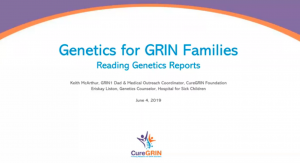Unraveling GRIA1 neurodevelopmental disorders: Lessons learned from the p.(Ala636Thr) variant
Share This Post
Written by: Kat Reiher, CureGRIN Ambassador
Edited by: Meagan Hutchinson, CureGRIN Research Manager
Hello everyone! My name is Kat Reiher. I’m the Lead Ambassador for CureGRIN and I want to tell you about an article on GRIA1 that was recently released!
The article is called “Unraveling GRIA1 neurodevelopmental disorders: Lessons learned from the p.(Ala636Thr) variant”.
A really exciting thing about this study is that they studied the exact same variant in EIGHT different people. For most GRI variants, we only have one, occasionally two people with the same exact variant so this was unprecedented. They also compared this variant to very similar mutations in other GRI genes.
This is only the third study to investigate GRIA1 variants in the context of neurodevelopmental disorders, such as developmental delay, epilepsy, and autism. In the first two studies, a total of 12 patients with GRIA1 variants were reported, with six of them carrying a recurrent gain-of-function (GoF) variant, p.(Ala636Thr). In this third study, researchers followed up with some of the patients carrying the p.(Ala636Thr) GRIA1 variant to assess their progress. Additionally, they identified five new patients with this specific variant, bringing the total number of known cases to 11. In this third paper, the researchers were able to report detailed health information about 8 of these 11 patients.
One of the mysteries about GRI disorders is why some patients are far more affected than others. It was interesting to find out that even among 8 patients with the same exact variant, there was a wide difference in abilities. This study found that all patients had developmental concerns before the age of two, primarily involving motor and speech delays. Although all patients learned to walk, many needed support for longer distances. Fine motor skills, such as using utensils and dressing, were impacted for most patients, with only a few able to button clothes or use zippers. Speech delays were common, with the first words appearing around 28 months, and only one patient remaining non-verbal by age three. Cognitive impairment was present in all patients, ranging from mild to severe, but no cognitive regression was observed. Behavioral challenges, including autism, ADHD, and anxiety, were common, along with mood swings and difficulties in social interactions. All children were enrolled in educational programs with varying levels of support, while the only adult patient was fully institutionalized.
The last important thing I want to note is that they found that three patients (38%) with this GRIA1 variant developed seizures, and importantly, the average age for the development of seizures was six years old. Typically, most GRI doctors have thought that seizures usually develop by age 1, so the study noted the importance of continuing to watch for seizures throughout childhood. Luckily, two patients achieved seizure freedom with medication.
To learn more about this research, check out the journal article here: https://pubmed.ncbi.nlm.nih.gov/38890806/
If you are interested in enrolling your child in similar studies to gain a better understanding of GRIA disorders, you can contact Dr. Allan Bayat, an expert in this field. Dr. Bayat can be reached via email at abaya@filadelfia.dk.
Read more Posts

GRIN Genetics 101: Understanding Your Kid’s Whole Exome Sequencing Report (WES)
Share This Post Share on facebook Share on linkedin Share on twitter Share on email https://youtu.be/2Fd8LqjxDN0 When we become parents of rare disease kids, we’re
We’re living on a prayer that you will help us reach our goal!
Share This Post Share on facebook Share on linkedin Share on twitter Share on email Last month I wrote to tell you about our $250,000
